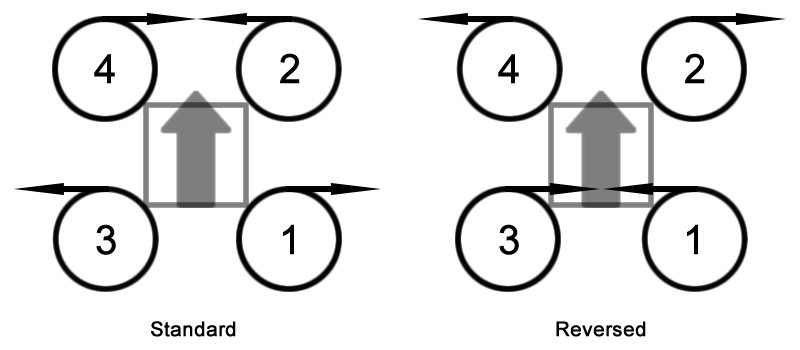The folks at the Tiny Whoop race last night were talking about reversed prop rotation. One of my friends mentioned that it is better for sharp yaw turns as well as aerodynamics. So I did some digging and came up with this youtube video related to the aerodynamic properties. I'm sold.
The inverse rotations of quadcopter motors is necessary to prevent the torque of the motors and the centrifugal forces from rotating the aircraft in the direction of the spin. The solution was simply to balance all forces involved by having clockwise and counterclockwise rotations. So traditionally the front motors spin the propellers inward, and the rear motors spin outward.
There's definitely nothing wrong with tradition if you fly line of sight, or fly a quadcopter in all directions. The aerodynamic benefits of making the fronts spin out and the rears spin in is only relevant to forward flight. So stop here if you are not driving an FPV Racer.
In my opinion there is no risk trying this. As stated, the purpose of the opposite rotating motors is to simply balance the craft so it doesn't inherently want to go in one particular direction. So no big Whoop if the fronts spin out instead of in. It's about the balance. But, back to the aerodynamics:

In forward flight, the advancing blade produces more thrust than the retreating blade. The difference is relative to the air flow/forward velocity. On a per motor/prop basis, this has the effect of pushing the center of trust toward the advancing blade. In the standard configuration, the front props spin inwards, hence the center of thrust is pushed outward in forward flight because the leading edge of the advancing prop is outboard.
In forward flight, the nature of the dirty air being fed back to the rear motors lessens their effectiveness. That combined with the fact that the center of thrust is inboard makes for a double penalty. So reversing the rears immediately gains some thrust authority said dirty air considered. The reason they turn better in the reversed configuration is because in yaw turn situations, the air being fed to the rear props is even dirtier than in forward flight.center of thrust is pushed outward. This is because the advancing blade is outward, producing most of the thrust.
Confused yet? Just think forward. Lets take the right rear motor: Spinning in the standard clockwise rotation, the leading edge of the prop is facing rearward, not producing as much thrust as the inside of the prop which is facing forward. Hence the center of thrust is inboard, where the dirty air is.
If you swap the right rear rotation, to inward, then the outside leading edge will be in much cleaner air, and produce more efficient thrust.
My Take on It
Scale. It's all about scale. I will report back on this one after I try it, but consider this: The effects and advantages are proportional to your speed. If you are running 80mph and ripping turns, you will probably have more of an advantage than a micro, just putting around. I also envision some of the effect is minimized by the ducted fan setups of the micros.
Updates
Holy craft. I had no idea. If you have an inductrix style frame, or a tiny whoop, with the motors that angle slightly. Do this. It's a must. I had low expectations, which are now converted to pure astonishment. The micro sounds totally different, and it flies 20% better stability wise. It's like night and day. I did a little more research, and read about additional improvements related to the angle at which the motors are mounted on the micro style frames. The standard motor rotation causes turbulence. Boom. Not any more. I will be switching out on my 4" tomorrow and will report back on differences in a larger frame.
 Adam J Nowak
Adam J Nowak
0 Comments